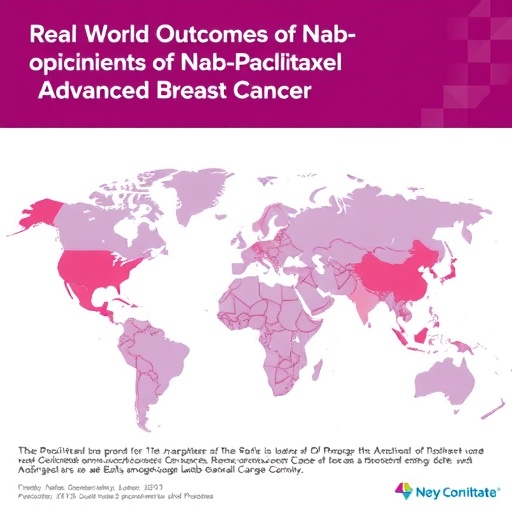In the evolving landscape of cancer treatment, the efficacy of therapies in real-world settings often garners considerable attention. A pivotal investigation into this realm is the SERAPHINA study, which explores the use of nab-paclitaxel for patients grappling with advanced breast cancer. This research, spearheaded by an esteemed team including Schneeweiss, Fasching, and Thill, seeks to unravel the complexities surrounding both the effectiveness of the drug and its management in practical scenarios, diverging from the traditional confines of clinical trials.
Nab-paclitaxel, a formulation of the chemotherapy agent paclitaxel, has gained prominence due to its mechanism that inhibits cancer cell division. It does so by disrupting the normal function of microtubules, thus preventing cells from successfully navigating through the critical process of mitosis. The SERAPHINA study’s focus on this drug arises from its ability to significantly enhance drug delivery to the tumor site while concurrently reducing systemic toxicity—benefits that are undeniably crucial for patients facing the relentless battle against advanced breast cancer.
As the study unfolds, one salient aspect is the examination of nab-paclitaxel’s efficacy in a diverse population of patients in real-world clinical settings. Unlike strictly controlled environments typical of initial clinical trials, real-world studies allow for the inclusion of various patient demographics, presenting a noteworthy opportunity to assess how nab-paclitaxel performs across a broader spectrum of conditions. This inclusive approach lays the groundwork for a more comprehensive understanding of treatment efficacy and variability in response rates.
With advanced breast cancer presenting multifaceted challenges, the study also delves deeply into therapy management strategies. One central theme of the research is the meticulous coordination among healthcare professionals to optimize the administration of nab-paclitaxel, which calls for a nuanced understanding of the patient’s overall health and treatment history. The integration of multidisciplinary teams is vital for tailoring the treatment approach, as each patient’s response can differ markedly based on various factors such as genetics, previous treatments, and comorbidities.
From the outset, the SERAPHINA study chronicles patient responses, tracking critical metrics like overall survival rates, progression-free survival, and quality of life indices. These findings will not merely illuminate the raw statistical outcomes but will also provide insight into the nuanced experiences of patient cohorts. By considering subjective quality-of-life measures alongside objective clinical endpoints, this research endeavors to provide a rounded perspective on treatment impact.
Moreover, the study advances the discussion around personalized medicine in the treatment of advanced breast cancer. By highlighting individual patient profiles and their unique responses to nab-paclitaxel, the researchers underscore the necessity of customizing treatment plans to align with patient-specific characteristics. This bespoke approach represents the future of oncology, shifting the paradigm towards more individualized strategies that could significantly enhance outcomes.
Among the compelling dimensions explored in the SERAPHINA study is the economic aspect of integrating nab-paclitaxel into treatment regimens for advanced breast cancer. As healthcare systems worldwide grapple with rising costs, the resource allocation for therapies such as nab-paclitaxel comes to the forefront. The researchers analyze not only the direct costs associated with the drug but also the broader economic implications of improved patient outcomes, potentially leading to reduced hospitalization rates and less need for subsequent treatments.
In traversing the landscape of nab-paclitaxel’s application, the study also addresses the management of side effects, which is a crucial component of cancer therapy. The experience of adverse effects can significantly influence a patient’s quality of life and overall treatment adherence. By collecting data on the spectrum of side effects experienced by patients receiving nab-paclitaxel, the study aims to elucidate the risk-benefit profile of the drug, equipping healthcare providers with knowledge to better manage these complications.
An exciting aspect of the SERAPHINA study is its examination of patient-reported outcomes, which adds a vital layer of depth to the traditional clinical metrics. Understanding patients’ perspectives on their treatment experience can shed light on how nab-paclitaxel affects their daily lives, interactions with the healthcare system, and emotional well-being. Acknowledging and prioritizing these patient narratives is essential for fostering a more empathetic and responsive healthcare environment.
The significance of the SERAPHINA study extends beyond its immediate findings. It represents a growing recognition within the medical community of the importance of real-world evidence to inform clinical practice. As traditional randomized controlled trials often face criticism for their limited applicability to general populations, studies like SERAPHINA stand as beacons, emphasizing the value of real-world data in bridging the gap between clinical research and everyday patient care.
As the SERAPHINA study prepares for publication, there is palpable anticipation regarding its implications for the future of breast cancer treatment. The researchers’ findings could serve as a pivotal reference point for oncologists, guiding them in making evidence-based decisions that will shape the standard of care for advanced breast cancer patients. The outcomes may also pave the way for further investigations into similar therapeutic strategies, ultimately furthering the ongoing battle against cancer.
In conclusion, the SERAPHINA study offers a groundbreaking exploration into the real-world efficacy of nab-paclitaxel for advanced breast cancer treatment. By intertwining rigorous scientific methodology with a patient-centered approach, this research not only amplifies the discourse surrounding cancer therapies but also anticipates a future where personalized treatment strategies can make a profound difference in the lives of those affected by this unforgiving disease.
Subject of Research: Efficacy and therapy management of nab-paclitaxel in advanced breast cancer.
Article Title: The efficacy and therapy management of nab-paclitaxel in the real-world setting for patients with advanced breast cancer – the SERAPHINA study.
Article References:
Schneeweiss, A., Fasching, P.A., Thill, M. et al. The efficacy and therapy management of nab-paclitaxel in the real-world setting for patients with advanced breast cancer – the SERAPHINA study.
J Cancer Res Clin Oncol 151, 192 (2025). https://doi.org/10.1007/s00432-025-06246-2
Image Credits: AI Generated
DOI: 10.1007/s00432-025-06246-2
Keywords: nab-paclitaxel, advanced breast cancer, SERAPHINA study, real-world evidence, personalized medicine, patient-reported outcomes, chemotherapy efficacy.




